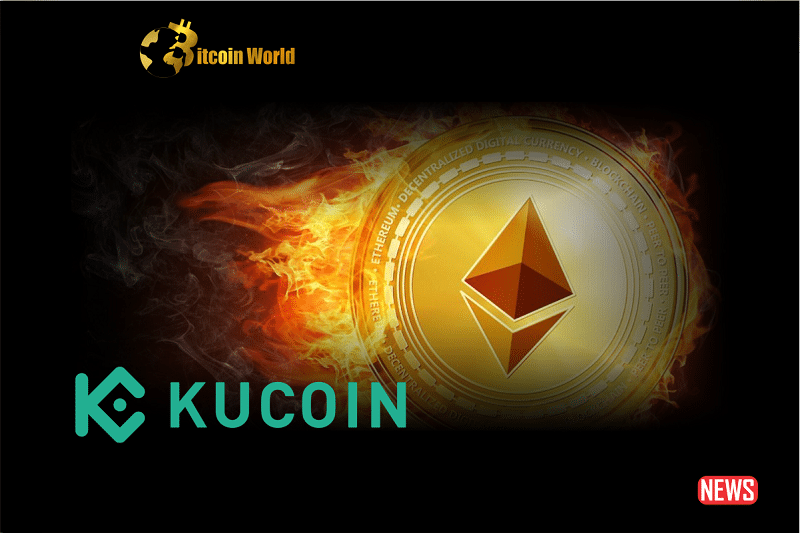Imagine a digital bonfire, but instead of wood, it’s millions of dollars worth of Ethereum disappearing into thin air. That’s essentially what happened in September 2021, sending ripples through the crypto community. Intrigued? Let’s dive into this fascinating event and explore its implications for the future of Ethereum.
The Curious Case of the Missing ETH: What Happened on KuCoin?
In a move that raised eyebrows across the crypto sphere, a staggering amount of Ethereum’s native token, $ETH, was sent from numerous deposit addresses on the popular exchange KuCoin to a ‘burn address’ – a digital black hole from which there’s no return. Over three days, starting September 7th, over 3,500 transactions involving both ETH and Tether’s $USDT stablecoin were executed, totaling millions of dollars. This unusual activity was brought to light by Conor Grogan, a director at Coinbase, who utilized data from Arkham Intelligence to spotlight the situation.
Here’s a quick breakdown of the key details:
- Timeline: Started on September 7th, 2021, and lasted for three days.
- Exchange Involved: KuCoin
- Tokens Burned: Ethereum ($ETH) and Tether ($USDT)
- Number of Transactions: Over 3,500
- Discovery: Highlighted by Conor Grogan (Coinbase) using Arkham Intelligence data.
Token Burning Explained: Why Send Crypto to Nowhere?
So, what exactly is token burning, and why would anyone do it? Think of it as permanently taking tokens out of circulation. When tokens are sent to a ‘burn address’ – specifically the null address on Ethereum – they become irretrievable. This is a common practice in token economics, often used to:
- Reduce Supply: Similar to a company buying back its own stock, burning tokens decreases the total supply.
- Potentially Increase Value: With fewer tokens available, the remaining ones might become more valuable if demand stays constant or increases.
- Reward Holders: Some projects implement burn mechanisms as a way to reward long-term holders.
While token burning itself isn’t unusual, the sheer volume of ETH burned from KuCoin in such a short period, without an immediately obvious explanation, is what sparked curiosity and speculation.
The Bitfinex Connection: A Possible Explanation?
Conor Grogan proposed an intriguing theory: the USDT tokens involved might have been redeemed through a special arrangement with Bitfinex, another major cryptocurrency exchange and the primary operator of USDT. While the exact reasons remain unclear, this suggests a potential behind-the-scenes maneuver involving the stablecoin.
EIP-1559: The Game Changer in Ethereum’s Tokenomics
Adding another layer to this story is Ethereum’s significant EIP-1559 upgrade, implemented in 2021. This update introduced a mechanism to burn a portion of the gas fees (transaction fees) with every transaction. This marked a fundamental shift in how Ethereum’s supply is managed.
How Does EIP-1559 Contribute to Token Burning?
Before EIP-1559, gas fees went entirely to miners. Now, a base fee is burned, effectively reducing the overall ETH supply. This has a profound impact on Ethereum’s tokenomics.
The Deflationary Trend: Is Ethereum Becoming Scarcer?
The combined effect of EIP-1559 and events like the KuCoin burn contributes to a fascinating trend: Ethereum potentially becoming deflationary. Let’s break down the numbers:
- Supply Reduction: Due to burned transaction fees and the recent shift to a Proof-of-Stake network (the Merge), Ethereum’s supply has been decreasing.
- May 2023 Example: In May 2023 alone, Ethereum’s supply decreased by approximately $275 million, or 143,000 ETH.
- Issuance vs. Burning: During that month, 56,680 new ETH were issued, but a significant 199,670 ETH were burned.
- Negative Supply Growth: This resulted in a -1.46% supply growth rate, indicating deflation.
This deflationary aspect is a hot topic among crypto enthusiasts. The logic is simple: if demand for Ethereum increases while its supply decreases, the price could potentially rise. It’s basic economics at play.
Looking Ahead: What Does This Mean for Ethereum’s Future?
The ongoing reduction in Ethereum’s supply has sparked optimistic price predictions. Consider this:
- VanEck’s Prediction: The global asset manager VanEck projects Ethereum could reach $11,800 by 2030.
- Factors Considered: Their model takes into account Ethereum’s hard fork and its competition with traditional assets like US Treasury notes.
- Ethereum’s Role: They recognize Ethereum’s growing importance as a store of value and a settlement network for smart contract platforms.
VanEck’s analysis, based on revenue, cash flow, and various market scenarios, paints a bullish picture for Ethereum’s long-term prospects.
Conclusion: A Burning Question with a Promising Outlook
The mystery surrounding the massive ETH burn on KuCoin in 2021 continues to fuel speculation. Whether it was a strategic move, an operational error, or something else entirely, the event underscores the dynamic nature of the cryptocurrency world. Coupled with the effects of EIP-1559 and the ongoing deflationary trend, this incident highlights the evolving tokenomics of Ethereum. As its supply potentially shrinks and its utility as a foundational asset grows, the stage may be set for significant future developments and potential price appreciation. The flames of those burned tokens might just be igniting a brighter future for Ethereum.
Disclaimer: The information provided is not trading advice, Bitcoinworld.co.in holds no liability for any investments made based on the information provided on this page. We strongly recommend independent research and/or consultation with a qualified professional before making any investment decisions.


